On the Road in Kenya: Secretary Clough’s travel journals
Secretary Wayne Clough, along with several other Smithsonian scientists, is in Kenya to understand the research programs and opportunities at the Mpala Research Centre. The Smithsonian is a partner in the administration of the center. Secretary Clough has agreed to share his observations with The Torch.
Photo: (Click on thumbnail for full-size image.) The brilliant marico sunbird. (Photo courtesy of Brad Bergstrom)
June 16, Mpala Research Centre, Laikipia, Kenya. Weather—cool breezes, clear, sunny.
There are more than 300 species of birds on the Mpala Ranch and it is easy to appreciate their beauty and vitality. The bird feeder on our porch serves up a bit of theater as it attracts a raucous crowd who jockey for a turn at the feeder. The joker in the deck is a vervet monkey who also likes the fruit the staff puts out. He has to be shooed off before he cleans out the feeder.
The feeder attracts small and large customers. The smaller birds include the yellow-fronted canary and the sparrow weaver. They have to compete with the larger superb starlings, doves and hornbills.
(Interruption—while writing this on the back porch, two beautiful giraffes stroll up to watch the humans. They have a long look before loping off to more open territory.)
For those of us from urban areas it may be hard to imagine a “superb” starling, but these fellows deserve the name—they are plumed with iridescent blue feathers on their backs and orange/brown feathers on their breasts. The doves are much like those we know in the United States but the males have red colorings around the eyes. Hornbills are large gregarious birds that mate for life. The pair that visit the feeder not only enjoy the food but also seem expressively curious about the humans watching them.
Other birds that frequent the grounds include the beautiful marica sunbird that feeds on nectar from long-throated flowers. Common guinea hens move in flocks kicking up dust as they scour the ground for insects. Less seen and shyer birds include the hadada ibis and the lovely black-crowned tchagra.
It is tempting just to sit on the porch and watch the parade of birds and animals that just show up. But, we use the early morning of this day for one more wildlife drive. A new addition to my list of animal sightings is the eland, another of the large number of grazing animals found here. The eland is a powerful animal with short horns that spiral out from the head.
Our drive takes us along a road between the river and a high ridge, a favorable haunt for raptors who feed on fish and land animals. Sightings include Verreaux’s eagle, a dark chanting goshawk, and an augur buzzard. All are beautiful creatures, including the augur buzzard, which looks nothing like its U.S. relatives, but more like a fish eagle.
We also see impala, baboons, zebras, giraffe and waterbucks. There are also four or five groups of elephants, most with calves. We stop to watch the elephants and take a few pictures. Where the road takes us close to a group, the mother elephants become nervous, and let us know our presence is not appreciated with loud growling and shrieks and wagging of their ears. We move along rather than risk the wrath of the elephants.
After lunch we tour the “tented village,” an area used by up to 30 visiting students and their faculty advisors. This accommodation and the housing at the Research Centre is available for researchers from universities and other organizations in support of their investigations related to African wildlife and environmental issues, particularly those pertinent to Mpala. Along with the Smithsonian, Princeton University has been involved with Mpala since the Research Centre was formed, but faculty and students from many other universities take advantage of the opportunities offered here.
Late in the day a group of us have the opportunity to visit the field research site of Dino Martins, a Harvard University scientist who is studying the symbiotic relationship between various types of ants and acacia bushes. Dino is a native Kenyan who cut his research eyeteeth working at Mpala with the Smithsonian’s own Scott Miller. The acacia is the most commonly found plant found at Mpala, ranging in size from almost a groundcover to the size of small tree. . In all cases, the plant is equipped with long, sharp thorns to help protect it from the many grazing animals at Mpala. It also has another defense—the colonies of ants that live in the bulbous hollow knobs that form at the joints of the plant. Dino explains that the ants can be of many species, some very aggressive and some less so. The ants boil out of their homes at the first sign of any vibration or disturbance, such as a light tap with a stick, ready to defend their turf. The most aggressive ants will jump from the plant onto a human and their biting can cause considerable discomfort. In the course of his research, Dino has been bitten many, many times, but he seems to take it all in stride as he explains his findings with enthusiasm.
The ants help protect the acacia and in turn, the bush provides the ants with homes and food harvested from the inside of the acacia’s bulbous knobs.. This remarkable relationship between plant and ant is not yet fully understood and Dino is excited about his study. He notes that a fungus grown by the ants may have positive pharmaceutical applications. Dino also points out that in terms of sheer biomass, the cumulative biomass of ants at Mpala is greater than that from the combined weight of the humans and animals there.
It seems fitting that my last trip into the field at Mpala dwells on ants and the way in which they serve a crucial purpose in the ecosystem. From tiny ants to huge elephants, all are part of a complex web of life at Mpala and similar places that we do not yet fully comprehend. If we are to make the right decisions about this complex ecosystem in the future so that the great animals will survive, it must be based on the knowledge of how all the parts work together, and this is why research is essential for the future.
We close our time at Mpala with another enjoyable dinner with our colleagues and people we have come to admire. As the person responsible for the research enterprise, Margaret Kinnaird brings talent and grace to her work. As the manager of the ranch, and impresario of wildlife drives, Mike Littlewood brings a unique knowledge of Kenya, her people, animals and all things practical, such as how to drive a Land Rover at 50 mph over washboarded roads while avoiding goat herds. We have greatly enjoyed our time here and have memories we will not forget. We thank all of those who have contributed to this exceptional opportunity.
From Mpala, we head back to Nairobi where, on our last day in Kenya, we make courtesy calls on SI partners and others to say hello and hear from them their thoughts about the future of Kenya, its wildlife and the role of Mpala. Visits to Kenya Wildlife Service, the National Museums of Kenya, and the U.S. Embassy to meet with Ambassador Michael Rannenberger conclude our visit. It is clear that the presence of the Smithsonian Institution is an important element in bringing credibility and research expertise to the work done at Mpala.
Time to return to Washington. It will be a long flight, but the trip was truly worth the effort. We will have to make challenging decisions in the days ahead as to where and how the Smithsonian will apply its funding and effort, but being able to see places like Mpala firsthand will help guide our choices.
(Secretary Clough’s earlier journal entries follow.)
June 13, Mpala Research Centre, Laikipia, Kenya. Weather— clear, high clouds, cool and dry.
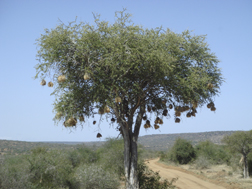
The nests of weaverbirds can be seen dangling from the branches of the tree. (Photo by Wayne Clough)
Our room at Mpala Ranch looks out over a slope that leads to the Ewaso Niro River. Beyond the river, the ground rises with rocky promontories protruding from the otherwise gentle tree-covered slope. On the far horizon the outline of Mount Kenya is seen with its peak rising to 15, 000 feet. The ranch accommodations are a series of low stucco and stone buildings painted white, surrounded by straw-roofed porch. The grounds are home to stands of trees and other plants of the type that grow in hot, dry climates. The green spiny cactus contrasts with the exotic deep reds and oranges of the delicate bougainvillea. In a nearby “yellow fever” tree, weaver birds have built their hanging nests and are busy flitting back and forth bringing food to the young.
Our busy schedule does not allow much time to contemplate the pleasant surroundings. Saturday morning we rise early for a plane ride to view the ranch and the surrounding tracts of land that affect Mpala and its wildlife. The Mpala reserve itself covers 48,000 acres, but many of the animals are migratory and their routes take them across both privately and publicly owned lands, including ecotourism preserves, community lands used for raising cattle and goats and land set aside for conservation. Mpala is unique in that it is an active science- and research-based preserve.

This aerial view shows the boma, or corral, that protects the familiy's animals from predators at night. (Photo by Wayne Clough)
During the flight, we see the impact of humans and animals on the land. In a number of areas where the land has been preserved, there is a cover of trees and grasses. Upscale ecotourism lodges can be seen in some of the more scenic mountain areas. In contrast, the community lands have been heavily grazed, to the point that there is little ground cover left. Goats and cows are tended by families who live in thatched huts. The animals roam during the day and in the evening are herded back to the herders’ huts and corralled in “bomas” created by erecting barriers of limbs and thorny bushes. The bomas help protect the animals from attack by lions and other predators.
The grasses are not only grazed by domesticated animals but also by many of the wild species, such as gazelles, bushbucks, waterbucks and impalas. Overgrazing by large herds leads to poor nutrition for the animals and erosion of the topsoil. The topsoil is relatively thin and was formed by weathering of the underlying bedrock. Once the topsoil is eroded, the rock is exposed, and runoff from rainfall causes more erosion downstream, threatening the wellbeing of the region’s ecosystems.

Goats and cattle have contributed to overgrazing of community lands near Mpala. (Photo by Wayne Clough)
The lack of water is also a serious problem. This is the end of the rainy season, but already many of the rivers and small reservoirs are dry at a time when they should be full to carry through the dry season. Water naturally is in short supply here because the region on average only receives around 20 inches of rain each year. The situation is exacerbated by a growing trend of Kenyan farmers tapping water from the rivers and groundwater for irrigation. A recent development in Kenyan agriculture is exporting cut flowers. This expanding market for Kenyan farmers is made possible because the flowers, cut early in the day, can be flown to European and even U.S. markets the next day.
Between the shortage of water, the erosion of topsoil and the growth of the human population, the ecosystem and the animals are at risk. Traditional migration routes for animals such as elephants are disrupted in congested areas. In light of this, Mpala becomes all the more important, not only as a preserve for wildlife, but also as a center to do the research needed to find the balance point between animal and human needs.
Following the flight, the members of Mpala’s advisory and research boards meet to discuss the center’s future. Mpala has been blessed with good leadership, beginning with Sam and George Small, and then in their turn, Don Graham, founder of the Graham Group and chair of the board of trustees of the Mpala Wildlife Foundation and trustee Dennis Keller, founding chairman of DeVry Inc. Others on the combined boards include Dan Rubenstein of Princeton University; Laurel Harvey of Princeton; and Jeffrey Gonya of Venable LLP; as well as Ira Rubinoff and Scott Miller of the Smithsonian. The Smithsonian contingent also includes Ben Turner, a STRI soil specialist; Dave Wildt, a specialist in large animal reproductive physiology from the Center for Research and Conservation at the National Zoo; STRI Director Biff Bermingham; and STRI supporter Frank Levinson, founder of Finisar Corp.

Migratory animals such as elephants cover long distances over both public and private lands. (Photo by Wayne Clough)
The discussion is robust and many issues are debated and discussed. We have made a good start on identifying the themes and initiatives that should be Mpala’s focus in the next decade. It is agreed that the research program should be focused on the key challenges that threaten the immediate future of Mpala and the wildlife and ecosystems of East Africa. A tentative plan is laid out to accomplish these objectives that involves greater interaction with Kenyan universities to encourage greater involvement by young people who are committed to finding the delicate balance needed for a sustainable future in the region. The plans will be discussed and debated by the full governing board and scientific advisory boards later this week. These boards bring together key parties involved in Mpala’s future, including the Kenya Wildlife Service and the National Museums of Kenya.
After the meeting, we are treated to a second game drive as the day wanes. While we continue to observe wildlife, we also now take more time to consider the countryside itself. In the soft light of the late afternoon the beauty of the hills and valleys invades the mind. The seductive power of the Kenyan landscape that captivated Karen Blixen (Isak Dinesen) and inspired her book Out of Africa is only too apparent.
We continue to build our animal count, adding baboon (seen in a troupe of around 50 or 60), leopard tortoise, spotted hyena, golden jackal, waterbuck, common zebra, and Grant’s gazelle.
There are also opportunities to see giraffes, including family groups. These are reticulated giraffes with clearly defined brown spots outlined by white. The young giraffes are curious and arch their heads over trees to see what we are up to. When the parents leave, the youngsters linger a few minutes and then lope off to catch up. The mature giraffes are very graceful for such large and ungainly creatures. They have a remarkable ability to reach and eat the small green leaves that grow between long, sharp thorns on man of the trees and shrubs of the region.
Our game drive comes to an end with the approaching dusk and we return to the ranch for dinner and conversation about what we have seen and discussed that day. The day ends with our first night of solid rest as the jet lag wears off a bit.
June 12, Nairobi, Kenya. Weather: Sunny, warm and humid. Mpala Ranch (elev. 6000 feet): Sunny, warm, cool breezes.
The redoubtable Francine Berkowitz, director of international relations for the Smithsonian informs me that the Institution and its people are involved in activities in 88 countries, ranging from large permanent operations like the Smithsonian Tropical Research Institute in Panama to remote sites visited only occasionally by researchers and scientists collecting data. These international operations are critical to the diverse and varied work of the Smithsonian and that that is what brings me to Kenya.
I am here to visit the Mpala Research Centre, a 48,000-acre preserve that allows scientists and researchers to observe first-hand the wild animals of Africa that are at risk as the human population encroaches into what was once natural habitat.
Smithsonian scientists from the National Zoo, STRI, and the Museum of Natural History have worked at Mpala since the early 1990s when then-Secretary Robert Adams signed a cooperative agreement with the center. A number of SI researchers are at Mpala during my visit, including Biff Bermingham, STRI’s director; soil scientist Ben Turner, Senior Scientist Emeritus Ira Rubinoff and Dave Wildt, head of the Center for Species Survival at the Zoo.

Among the ways the Mpala Research Centre serves the surrounding community is with a mobile health clinic. The clinic brings basic health services, childhood immunizations and HIV/AIDS awareness training to 50,000 people a year.
At places like Mpala, there is a chance to preserve a part of the natural world that is fast disappearing. Mpala is home to a stunning array of African wildlife, as diverse as that found at larger preserves like Serengeti. At the same time, Mpala is situated among several working ranches and the Mpala Ranch itself has a substantial cattle herd. African people, including the fabled Maasai, occupy community lands and move their cattle and goats from one place to another to seek better grazing for their animals. Mpala offers the opportunity to understand how people and wild animals might coexist so that both can succeed. My job as Secretary is to better understand the Smithsonian’s role in this important work and how it may evolve in the future.
Kenya is a country blessed by geographical diversity, ranging from a windblown coastline and the high elevations of Mount Kenya to desert in the north. The Mpala Ranch is located roughly in the middle of Kenya, about 20 miles north of the equator. It lies on the flanks of Mount Kenya, an extinct volcano that looms to the east of the Ranch. Rainfall averages about 20 inches per year, but it is not consistent and currently, Mpala is in the throes of a drought.
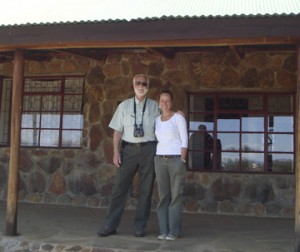
Wayne Clough and Margaret Kinnaird in front of the main building at the Mpala Research Centre. The building was constructed with a grant from the Smithsonian Women's Committee. (Photo courtesy of Wayne Clough)
Mpala Ranch owes its existence to the vision of two brothers, Sam and George Small who fell in love with this land. Sam purchased the land in 1952 and left it to George when he died in 1969. George believed the land should be preserved and used as a center for research into the preservation of the flora and fauna. He also understood the obligation of landowners to the people of the region and provided for a state-of-the-art health clinic and schools for the children. In 1989, George created the Mpala Wildlife Foundation. Mpala is funded through the foundation, established and administered by the Mpala Research Trust, in collaboration with Princeton University, the Smithsonian, the Kenya Wildlife Service and the National Museums of Kenya.
My wife, Anne, and I arrive in Nairobi early on the morning of the June 12 and are met by our Smithsonian colleague, Scott Miller, the Deputy Under Secretary for Science. Our journey from Washington, D.C., was to have taken about 24 hours, but due to weather delays for the first leg of our flight, we missed our connection from London to Nairobi and had to wait 12 hours for the next flight. We arrive in Nairobi at around 6 a.m. after 36 hours of travel, a bit wanting for sleep, but excited about being here. In Nairobi we transfer to a local airport for the short flight to Mpala. On the drive to the airport, we watch Nairobi waking up. Throngs of people are on the move. The streets are full of cars, trucks, buses and bicycles. There are thousands of pedestrians, including boys and girls in school uniforms. The school buses illustrate the religious diversity of Kenya with some representing Christian schools and others, Muslim schools.
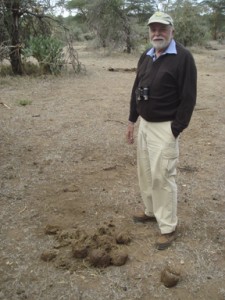
Ira Rubinoff displays acute powers of scientific observation and concludes that elephants may be in the area. (Photo courtesy of Wayne Clough)
Our Mpala flight initially takes us over land that is as green as Ireland, indicating high levels of rainfall and rich soil. As we continue north and come within sight of Mount Kenya and its peak, the land becomes brown and reflects a transition to a country with low precipitation. We learn later that much of the land also has been overgrazed by goats and cattle, as well as wild animals, causing serious problems in some areas near Mpala. Our pilot makes a low run over the dirt airstrip at Mpala Ranch to frighten off any animals that might be on the runway before we land smoothly in a cloud of dust. We are greeted by Margaret Kinnaird, executive director of the Research Center and others of the SI team who arrived earlier.
We drive in an old-school Land Rover over dirt roads to the Mpala Ranch headquarters. The trip is jolting at times when ruts and rocks are encountered. The Ranch is composed of a series of low stone and stucco buildings with sloped roofs. Each building, designed for utility, has its own character, and the ranch has a charm all its own in the middle of the large dry savannah. Our room is spacious with clay tile floors a large bed with a wrap-around mosquito net to keep the pesky creatures at bay.
We take lunch at the Research Center, a nearby complex of buildings with living quarters for students and visiting faculty, laboratories, computer rooms and an open-air dining hall. We are pleased to learn that the Smithsonian Women’s Committee provided funding for several of the buildings at the Research Center. After lunch we are treated to a series of talks that introduce us to the research done at Mpala.
At about 4 p.m. we break up and head out in Land Rovers on a “wildlife drive” to explore. Early on, we spot three cheetahs through binoculars. As we drive slowly along, the spotters on top of the vehicle thump the roof as a signal to spot if an animal is sighted. In some cases, you don’t really have to look very hard—elephants, gazelles and impala amble across the road at their pleasure. Others, like the beautifully colored bushbucks, shy from human contact. By the end of the wildlife drive, the list of species we have seen includes bushbuck, dik-dik, warthog, impala, giraffe, mongoose, oryx, elephant, hippo, Cape buffalo, kudu, cheetah, hyena and Grevy’s zebra (an elegant zebra with small black and white stripes). Remarkable!
We conclude the day with a wonderful al fresco dinner perched on a ridge overlooking a wide canyon. The air is sweet and the scenery distinctly Kenyan. With sunset, the temperature drops quickly and we crowd around a roaring fire. Finally, jet lag kicks in around nine and we call it an evening after an eventful day that we will long remember.
Posted: 15 June 2009
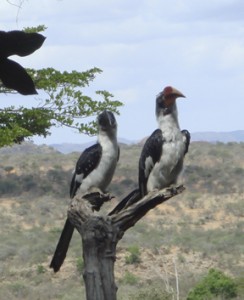
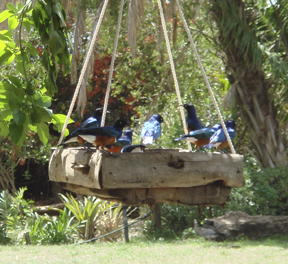









I don’t know who wrote the caption for the photo of Ira in the Secretary’s travelogue, but it’s a good one. Nice to see a sense of humor in the torch! (And Ira, you look great!) Great to read these articles–keep them coming.